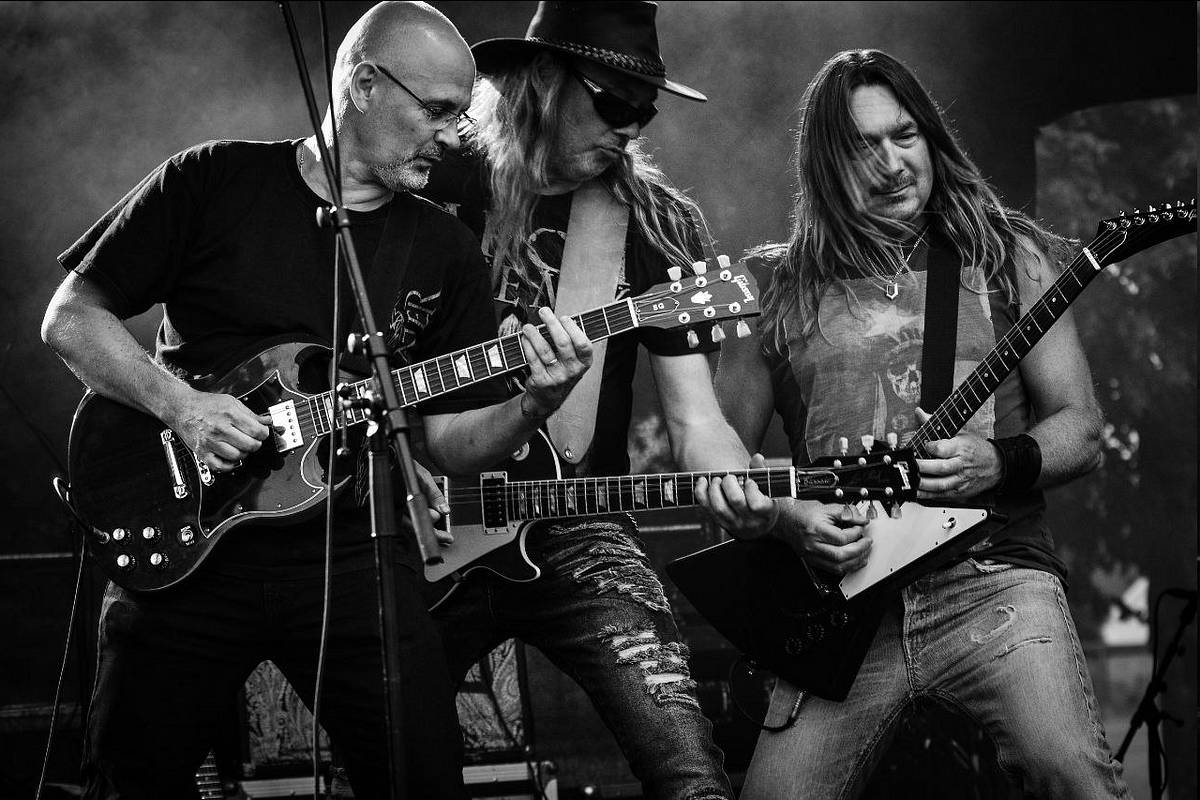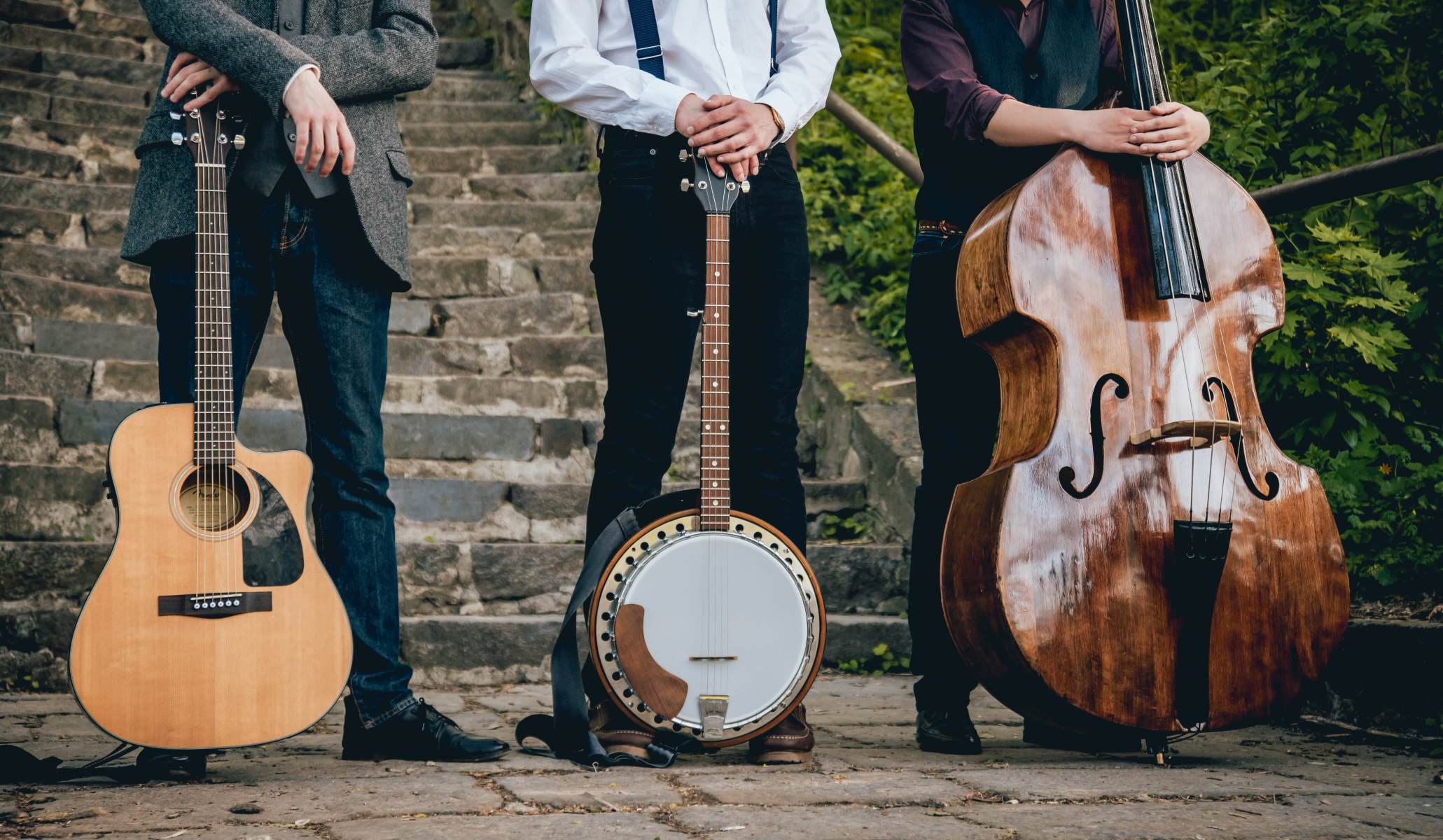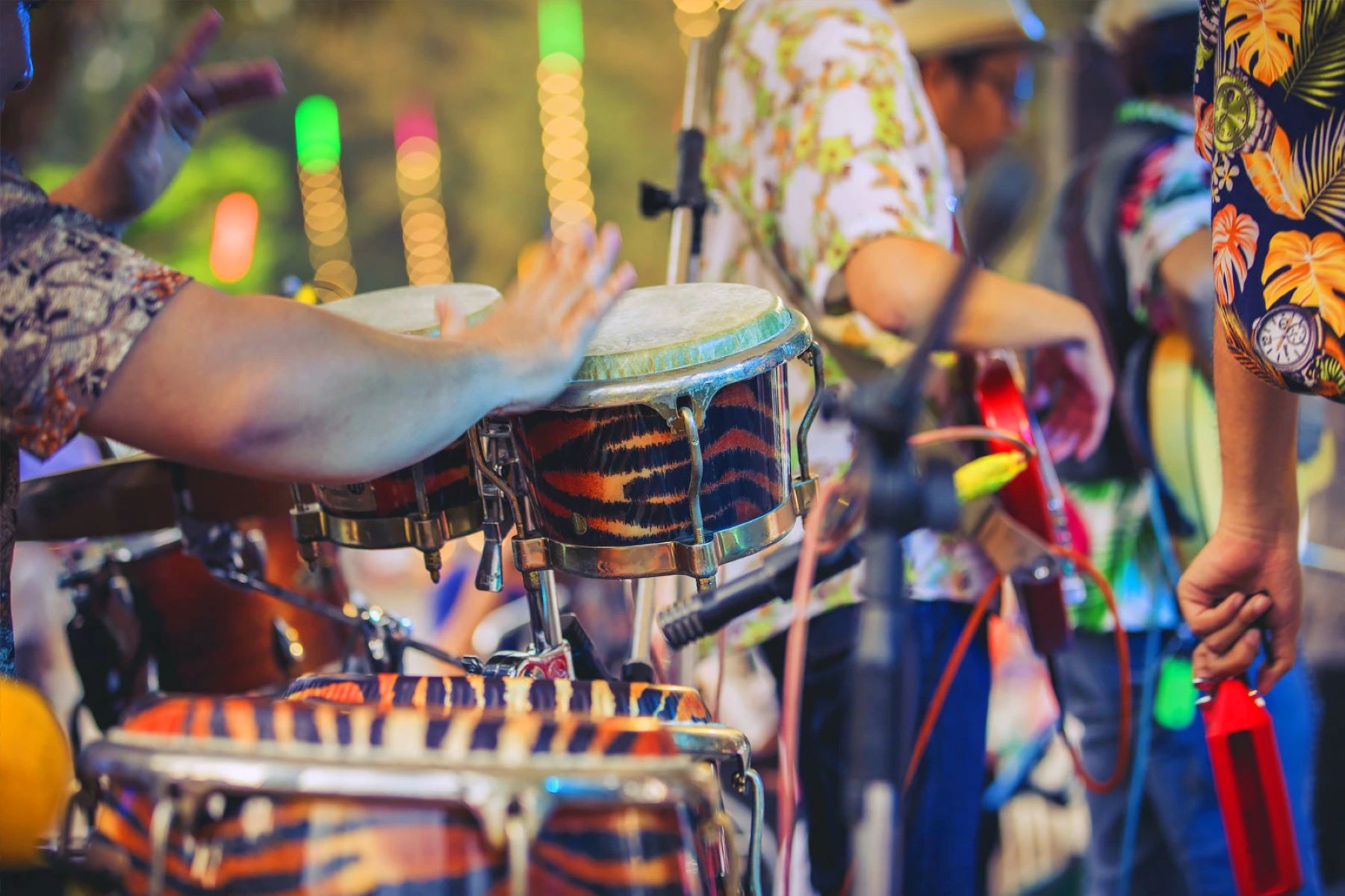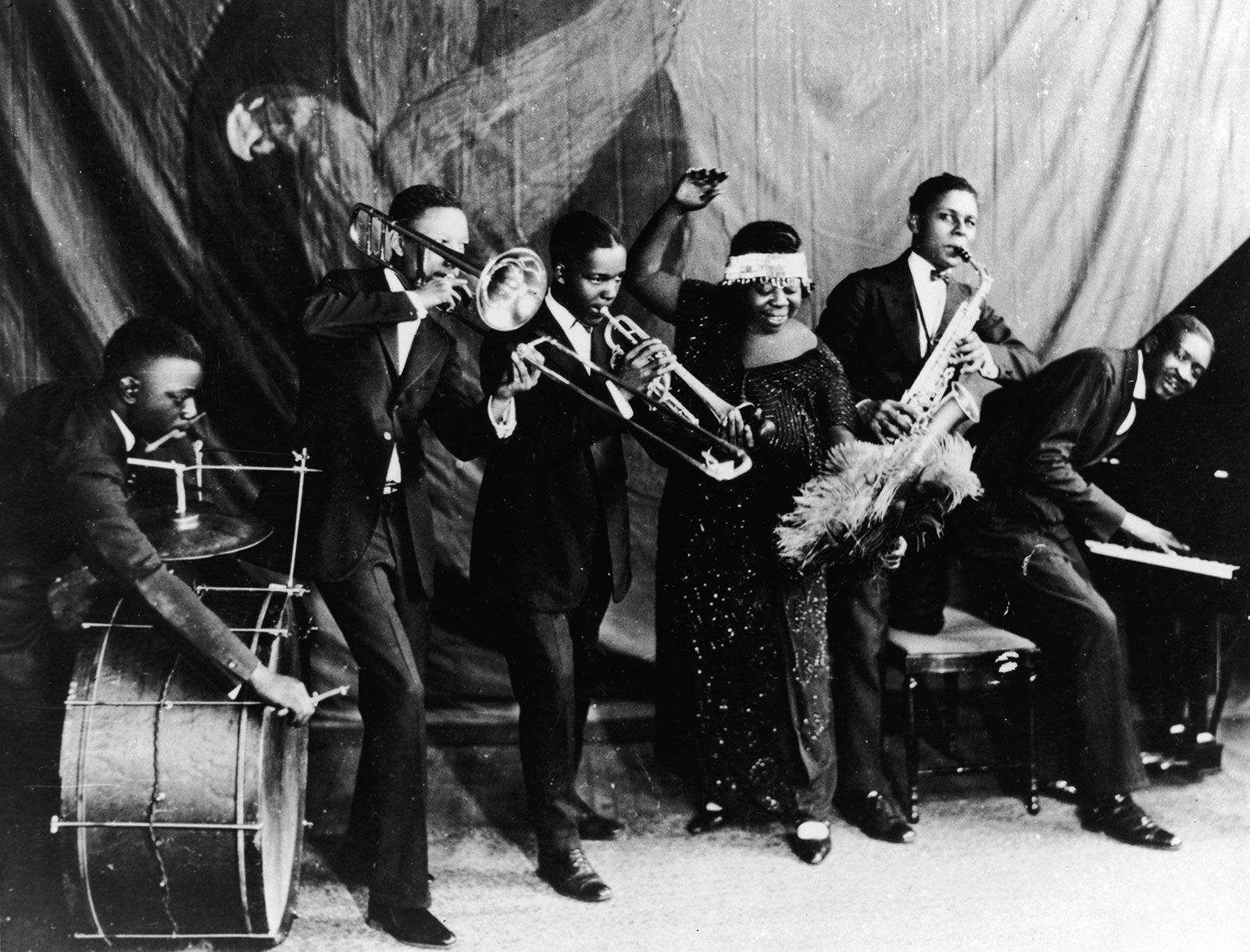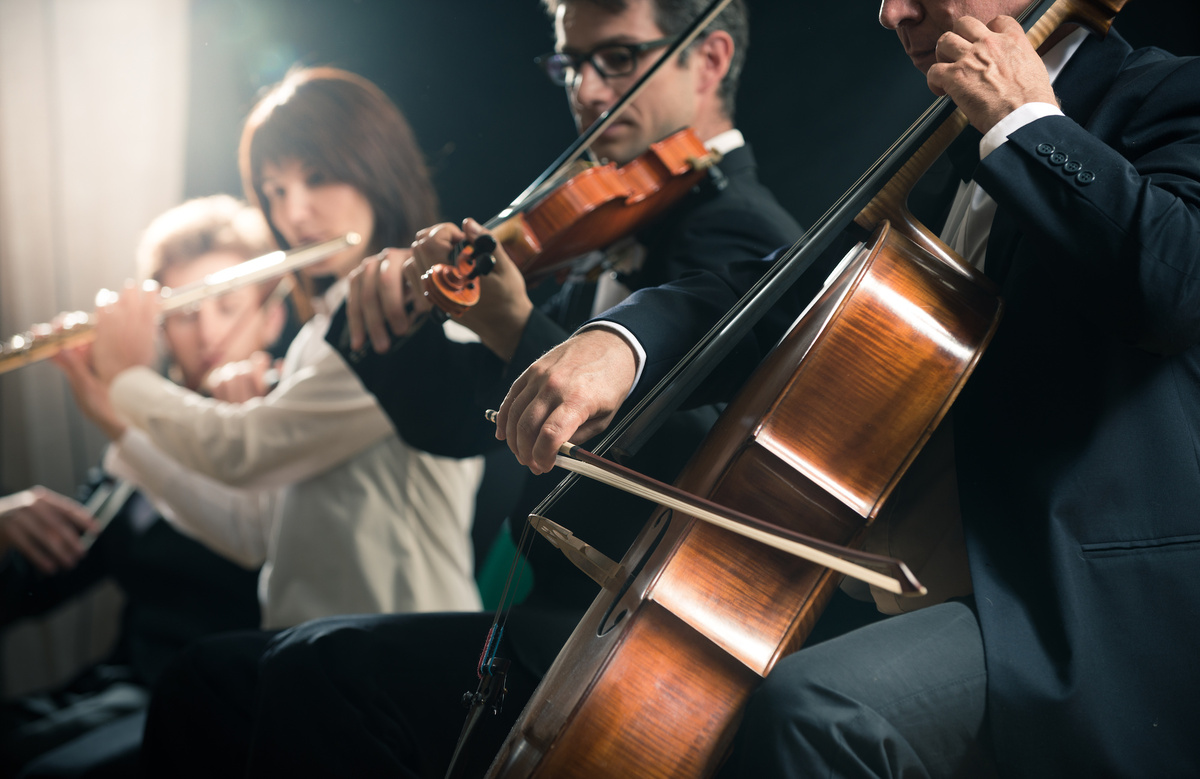

Rock
What Music Genres Influenced Rock And Roll
Modified: March 11, 2024
Discover the diverse music genres that shaped the evolution of rock and roll. Explore the influences of rock and its ever-evolving sound.
(Many of the links in this article redirect to a specific reviewed product. Your purchase of these products through affiliate links helps to generate commission for AudioLover.com, at no extra cost. Learn more)
Table of Contents
Introduction
Rock and roll, a genre that revolutionized the music industry, was heavily influenced by a diverse range of music genres. These musical styles laid the foundation for the energetic, rebellious, and visceral sound that became synonymous with rock and roll. Understanding the various genres that shaped rock and roll is crucial to appreciating the rich history and evolution of this iconic genre.
During the early 20th century, a cultural melting pot emerged in the United States. Immigrants from all over the world brought their own musical traditions, which blended with African American musical styles and the evolving technology of recording and amplification. This fusion of genres and influences created the perfect storm from which rock and roll would emerge.
In this article, we will explore several key genres that played a significant role in shaping rock and roll as we know it today. From the soulful sounds of blues and gospel to the infectious rhythms of swing and boogie woogie, these genres each brought their unique flavors to the table. By delving into the roots of rock and roll, we can gain a deeper appreciation for the transformative power of music.
Join us as we embark on a journey through time and delve into the music genres that left an indelible mark on rock and roll. Let’s dive in and discover the origins of this influential genre.
Blues
The blues is often considered the cornerstone of rock and roll. Originating in the African American communities of the Mississippi Delta, this genre emerged as a powerful expression of the hardships and struggles faced by African Americans in the early 20th century.
The blues is characterized by its soulful, emotive vocals, intricate guitar work, and a distinctive 12-bar chord progression. It served as a cathartic outlet for artists to express their sorrows, joys, and experiences. The raw emotions conveyed through the music resonated with people across racial and cultural boundaries, making the blues both deeply personal and universally relatable.
It was in the blues that rock and roll found its roots. The guitars wailed with passionate intensity, and the lyrics spoke of love, loss, and the human condition. The pioneering blues musicians, such as Robert Johnson, Muddy Waters, and B.B. King, laid the groundwork for the electrified sound that would come to define rock and roll.
Rock legends like Eric Clapton, Jimi Hendrix, and Stevie Ray Vaughan were deeply influenced by the blues. They took the raw energy and soulful essence of the blues and infused it with the electrifying distortion and energetic rhythms that became the hallmark of rock music.
The blues not only influenced the musical aspects of rock and roll but also its lyrical themes. The blues provided a platform for social commentary, discussing issues of inequality, love, and personal struggles. These themes would later carry over into rock and roll, allowing artists to address societal and personal issues with a raw and unfiltered voice.
The impact of the blues on rock and roll cannot be overstated. It brought a new level of authenticity, emotion, and intensity to the music. The blues set the stage for the wild, rebellious nature that would become a defining characteristic of rock and roll.
Incorporating the blues into the fabric of rock and roll was essential in forging a genre that would captivate audiences and propel musicians to new heights of creativity and expression. The blues lives on as a crucial element of rock and roll, reminding us of its rich history and its enduring power to move and inspire.
Jazz
Jazz, with its improvisational nature, complex harmonies, and infectious rhythms, played a significant role in shaping the sound and spirit of rock and roll. Originating in the early 20th century in African American communities, jazz quickly became a cultural phenomenon, capturing the hearts and minds of music lovers around the world.
The roots of jazz can be traced back to the African musical traditions brought over by enslaved people, combined with elements of European classical music and the evolving musical landscape of New Orleans. This fusion resulted in a vibrant and dynamic genre that pushed the boundaries of musical expression.
Jazz introduced a new level of virtuosity and improvisation to the world of music. Musicians like Louis Armstrong, Duke Ellington, and Charlie Parker pushed the boundaries of traditional musical structures, showcasing their technical prowess and creative genius. The improvisational nature of jazz allowed for spontaneous musical interactions and showcased the individuality of each musician.
Rock and roll borrowed heavily from jazz, incorporating its improvisational spirit and intricate harmonies into the genre. The influence of jazz can be heard in the extended instrumental solos, intricate chord progressions, and complex rhythms that became synonymous with rock music.
Jazz also played a significant role in shaping the performance style of rock and roll. The energetic and captivating stage presence of jazz musicians set the precedent for the high-energy performances of rock legends like Jimi Hendrix and Mick Jagger. Jazz performances were known for their improvisation and interaction between the musicians, creating a dynamic and engaging experience for the audience.
Beyond the musical influences, jazz also had a profound impact on the social and cultural aspects of rock and roll. Jazz, with its roots in African American communities, challenged racial segregation and became a symbol of cultural rebellion and liberation. This spirit of breaking boundaries and challenging societal norms would become integral to the rock and roll movement.
From the syncopated rhythms and complex musical arrangements to the improvisational spirit and cultural impact, jazz shaped the foundation of rock and roll. Without the influence of jazz, rock and roll would not have possessed the complexity, innovation, and rebellious spirit that made it such a transformative and influential genre.
As we explore the genres that influenced rock and roll, it is impossible to overlook the immense impact that jazz had on shaping the sound, style, and culture of rock music. Jazz remains an essential part of the musical landscape, reminding us of its enduring influence on the evolution of music.
Gospel
Gospel music, with its spiritual and uplifting themes, had a profound influence on the development of rock and roll. Rooted in African American religious communities, gospel music combines elements of traditional hymns, African rhythms, and soulful vocals to create a powerful and emotive sound.
At its core, gospel music is a deeply religious genre that celebrates faith, redemption, and spiritual awakening. It often features powerful vocal performances, call-and-response patterns, and lively rhythms that evoke a sense of joy and transcendence. The combination of heartfelt lyrics and soulful melodies created a genre that resonated with listeners on a spiritual and emotional level.
Many early rock and roll artists, such as Little Richard and Jerry Lee Lewis, were heavily influenced by gospel music. They borrowed the passionate vocal delivery and dynamic stage presence that were hallmarks of gospel performances. The influence of gospel can be heard in the energetic and spirited performances that became a defining characteristic of early rock and roll.
Lyrically, gospel music focused on themes of salvation, redemption, and hope. These themes were often brought into the rock and roll genre, albeit in a more secular context. The rebellious spirit of rock and roll often incorporated themes of escaping from social constraints and finding personal freedom, which paralleled the spiritual journey found in gospel music.
Gospel music also played a significant role in the civil rights movement of the 1950s and 1960s. The songs of freedom and empowerment resonated with activists and provided a soundtrack to the fight for equality. This social consciousness and emphasis on justice and equality would become intrinsic to the spirit of rock and roll, as artists use their music to challenge social norms and advocate for change.
Ultimately, gospel music brought a sense of spirituality, passion, and social consciousness to rock and roll. It demonstrated the power of music to evoke emotions, inspire change, and bring people together. The influence of gospel can still be heard in the soulful vocals, spiritual themes, and socially conscious lyrics that continue to shape the rock and roll genre today.
As we explore the genres that influenced rock and roll, gospel music stands as a testament to the transformative power of music and its ability to uplift, inspire, and unite people from all walks of life.
Rhythm and Blues
Rhythm and Blues, often abbreviated as R&B, played a pivotal role in the development of rock and roll. Emerging in the 1940s as a genre that blended elements of jazz, blues, and gospel, R&B laid the foundation for the energetic and soulful sound that would become synonymous with rock music.
At its core, R&B is characterized by its infectious rhythms, melodic hooks, and soulful vocals. It combined the raw emotion and lyrical themes of the blues with the energetic and danceable rhythms found in jazz and gospel music. R&B became a popular choice for African American audiences, who were searching for music that reflected their experiences and brought them joy.
R&B became a major influence on early rock and roll, as artists such as Chuck Berry and Fats Domino incorporated the genre’s rhythmic and melodic qualities into their music. The driving beats and catchy melodies of R&B laid the groundwork for the energetic and danceable nature of rock and roll.
The rise of R&B also brought about a change in the music industry, as it provided an avenue for African American artists to gain mainstream recognition. This paved the way for the integration of black and white artists in the rock and roll era, breaking down racial barriers and creating a more inclusive music scene.
R&B music also had a significant impact on the performance style of rock and roll. The electrifying stage presence and high-energy performances of R&B artists like James Brown and Ray Charles set the standard for the dynamic and captivating performances that would become a hallmark of rock music.
Lyrically, R&B explored themes of love, relationships, and the realities of everyday life. These themes resonated with audiences of all backgrounds, as they tapped into universal experiences and emotions. R&B lyrics often had a direct and relatable quality that would later be adopted by rock and roll artists.
Rhythm and Blues not only influenced the musical aspects of rock and roll but also the cultural and social dynamics surrounding the genre. It played a crucial role in breaking down racial barriers, creating a platform for diverse voices and musical styles to be heard and appreciated.
Today, R&B continues to be a vibrant and influential genre, with artists like Beyoncé and Bruno Mars carrying the torch and pushing the boundaries of the genre. The impact of R&B on rock and roll remains undeniable, as it shaped the sound, style, and cultural significance of the genre that continues to captivate audiences around the world.
Country
Country music, rich in storytelling and rooted in American folk traditions, has had a significant influence on the development of rock and roll. Originating in the rural communities of the southern United States, country music embodies the themes of love, heartbreak, and the struggles of everyday life.
Country music is defined by its distinctive twangy vocals, acoustic instrumentation, and heartfelt lyrics. It often explores themes of family, home, and the joys and hardships of rural living. These authentic and relatable stories resonated with audiences, creating a platform for artists to connect with listeners on a deep and emotional level.
Country music made its way into rock and roll through artists like Elvis Presley, who borrowed elements of country music in his early recordings. The blending of country and rock and roll gave birth to the subgenre of rockabilly, which combined the infectious rhythms and energy of rock with the storytelling and lyrical themes of country music.
Country and rock continued to intersect throughout the years, with artists like Johnny Cash, Willie Nelson, and the Eagles incorporating country elements into their music. The influence of country can be heard in the heartfelt storytelling, melodic guitar lines, and emotional vocals that became a signature of rock music.
Lyrically, country music often explores the universal themes of love, heartbreak, and the struggle to find one’s place in the world. These themes, expressed with sincerity and vulnerability, have resonated with fans across generations, providing a source of comfort and connection.
Country music also had a significant impact on the fashion and image associated with rock and roll. The cowboy boots, denim, and western-inspired attire became synonymous with the rebellious spirit of rock music, adding an element of ruggedness and authenticity to the genre.
The influence of country on rock and roll goes beyond just the musical aspects. Country music encapsulates a sense of community, storytelling, and cultural heritage. It reminds us of the values and traditions that have shaped American society, and its influence on rock and roll has contributed to the genre’s diverse and inclusive nature.
Today, country and rock continue to influence and inspire each other, forging connections between different musical worlds. The legacy of country music in rock and roll reminds us of the power of storytelling, heartfelt emotions, and the enduring appeal of music that speaks to our shared human experiences.
Folk
Folk music, with its emphasis on storytelling and acoustic instrumentation, played an essential role in shaping the ethos of rock and roll. Rooted in the traditions of various cultures and passed down through generations, folk music spoke to the human experience in a heartfelt and relatable way.
Folk music is characterized by its simplicity, authenticity, and often political or social commentary. It embraces a range of musical styles, from traditional ballads to protest songs, and its lyrics often tackle themes of social justice, love, and personal introspection.
In the 1960s, the folk music revival brought folk music to the forefront of popular culture, with artists like Bob Dylan and Joan Baez leading the way. Their stripped-down, acoustic sound and powerful messages resonated with a generation seeking authenticity and social change.
The influence of folk music on rock and roll can be heard in the introspective lyrics, acoustic guitar-driven melodies, and emphasis on storytelling. Many rock artists, such as Neil Young and Joni Mitchell, incorporated folk elements into their music, infusing it with a sense of introspection, social commentary, and emotional depth.
Folk music’s emphasis on personal expression also shaped the singer-songwriter movement within rock and roll. Artists like James Taylor and Carole King drew from the folk tradition, writing introspective and heartfelt songs that connected with audiences on a deeply personal level.
Furthermore, folk music brought a sense of community and social consciousness to rock and roll. The folk music revival of the 1960s fostered a collective spirit of activism and protest, using music as a tool for social change. This spirit would continue to inspire musicians to use their voices and platforms to address pressing social issues throughout the history of rock and roll.
Overall, folk music brought an introspective, storytelling quality to rock and roll, enriching the genre with heartfelt lyrics and a sense of authenticity. Its influence can be heard in the enduring appeal of a well-crafted song that speaks to the shared human experience and captures the essence of the times.
Today, folk-inspired elements can still be found in various forms of rock music, reminding us of the timeless power of music that tells a story and connects us to our roots.
Soul
Soul music, born out of the African American experience, brought a powerful and emotive energy to rock and roll. Emerging in the 1950s and 1960s, soul music blended elements of gospel, rhythm and blues, and jazz to create a genre that was deeply rooted in emotion and soulful expression.
Soul music is characterized by its passionate vocals, rich harmonies, and groove-driven rhythms. It captures the essence of human emotions, often exploring themes of love, heartbreak, and self-discovery. The raw and visceral nature of soul music resonated with audiences of all backgrounds, transcending racial and cultural boundaries.
The influence of soul on rock and roll can be heard in the powerful vocals, energetic performances, and the incorporation of horn sections and backup singers. Artists like Otis Redding, Aretha Franklin, and James Brown brought a new level of intensity and depth to their music, infusing rock and roll with soulful fervor.
Furthermore, soul music expanded the musical palette of rock and roll, incorporating elements of funk, Motown, and disco. These genres drew inspiration from soul and added danceable rhythms, catchy hooks, and a more polished sound to create chart-topping hits that would define the sound of the 1970s.
Lyrically, soul music delved into the complexities of human relationships, self-reflection, and social issues. The introspective yet relatable lyrics of soul songs brought a vulnerability and authenticity to the genre. These lyrical themes would continue to be explored in rock and roll, providing a deeper and more introspective approach to songwriting.
Soul music also played a crucial role in the civil rights movement, serving as an anthemic backdrop to the fight for equality and justice. Artists combined their soulful sounds with messages of empowerment, unity, and social change, using music as a tool for activism.
The soulful influence on rock and roll has persisted for decades. Artists like Prince, Tina Turner, and Amy Winehouse carried the torch, infusing their music with soulful passion and delivering powerful performances that captivated audiences.
Soul music continues to inspire and influence artists in various genres today, reminding us of the power of music to evoke emotion, connect people, and transcend barriers. Its impact on rock and roll cannot be overstated, as it brought a depth of feeling and a raw, honest expression that forever changed the landscape of popular music.
Swing
Swing music, with its infectious rhythm and high-energy performances, played a significant role in shaping the sound and style of early rock and roll. Emerging in the 1930s and 1940s, swing music dominated the dance halls and airwaves, captivating audiences with its lively tempo, horn sections, and vibrant improvisation.
Characterized by its upbeat and swinging rhythm, swing music transformed the way people perceived and interacted with music. The big bands of the swing era, led by legendary musicians like Benny Goodman, Count Basie, and Duke Ellington, created an irresistible sound that enticed people to dance and let loose.
The influence of swing on rock and roll can be heard in its lively and energetic performances. Swing music brought an infectious energy to the stage, with musicians engaging in lively call-and-response exchanges and showcasing their improvisational skills. These elements would later become key features of rock and roll performances, as artists sought to capture the same level of excitement and interaction with their audiences.
The emphasis on danceability and the use of horns and brass arrangements in swing music also influenced early rock and roll. The swinging rhythms and catchy melodies of swing were integrated into the sound of rock artists, giving their music a vibrant and dynamic feel.
Swing music also introduced the concept of the “soloist,” as musicians took turns showcasing their improvisational skills and pushing the boundaries of their instruments. This idea of individual expression within a larger musical ensemble would later become a hallmark of rock and roll, as artists like Chuck Berry and Jimi Hendrix dazzled audiences with their virtuosic solos.
Additionally, swing music had a significant impact on the culture surrounding rock and roll. It brought people together, fostering a sense of community and shared joy. Swing dance halls became social hubs, allowing people to connect, celebrate, and let loose. The spirit of togetherness and celebration that was inherent in swing carried over into the rock and roll era.
Although swing music eventually fell out of mainstream popularity, its influence on rock and roll remains undeniable. The lively and energetic performances, swinging rhythms, and emphasis on individual expression all contributed to the development of rock and roll as a genre that exudes excitement, freedom, and a rebellious spirit.
Swing music serves as a reminder of the transformative power of music, bringing people together and inspiring them to move and groove to the rhythm. Its impact on rock and roll shaped the genre into a force that would forever change the musical landscape.
Boogie Woogie
Boogie Woogie, with its infectious rhythms and energetic piano solos, had a significant influence on the development of rock and roll. Originating in the early 20th century, this dynamic piano-based genre emerged as a precursor to rock and roll, laying the foundation for its driving rhythms and catchy melodies.
Boogie Woogie is characterized by its repetitive bass lines, syncopated rhythms, and virtuosic piano playing. It emerged from the blues tradition, combining elements of ragtime, jazz, and swing. Boogie Woogie pianists, like Meade Lux Lewis, Albert Ammons, and Pete Johnson, brought a new level of excitement and energy to the piano, captivating audiences with their intricate and lively performances.
The influence of Boogie Woogie on early rock and roll is undeniable. The driving rhythm and lively piano playing found in Boogie Woogie provided the blueprint for the energetic and rhythmic style that would define the genre. Artists like Jerry Lee Lewis and Little Richard drew inspiration from Boogie Woogie, infusing their music with its energetic spirit and virtuosic piano solos.
Additionally, the repetitive bass lines and syncopated rhythms of Boogie Woogie laid the foundation for the rhythmic grooves in rock and roll. The lively and infectious beats provided a solid and danceable foundation that encouraged listeners to move and groove to the music.
Furthermore, the exuberance and energy of Boogie Woogie pianists influenced the performance style of early rock and roll artists. The wild and electrifying stage presence of Boogie Woogie pianists translated into the high-energy performances of rock and roll legends like Jerry Lee Lewis and Little Richard, setting the stage for the dynamic and captivating performances that are synonymous with rock music.
Boogie Woogie also brought improvisation to the forefront, as musicians would often take turns showcasing their virtuosic piano skills. The tradition of improvised solos and instrumental breaks that were hallmarks of Boogie Woogie performances would later become a cornerstone of rock and roll, as artists began incorporating extended guitar solos into their songs.
The influence of Boogie Woogie extends beyond just the musical aspects; it epitomizes the spirit of joyful expression and celebration. Boogie Woogie provided an escape from the hardships of life, inviting people to let loose and dance their troubles away. This spirit of celebration and release carried over into the rhythm and energy of rock and roll, as it became a genre that brought people together and encouraged them to express themselves freely.
Today, Boogie Woogie remains a vibrant and influential genre, reminding us of its lasting impact on the evolution of rock and roll. Its lively rhythms, virtuosic piano playing, and sense of joy continue to inspire and resonate with musicians and audiences alike.
Western Swing
Western Swing, with its fusion of country, jazz, and swing influences, played a significant role in the development of rock and roll. Emerging in the 1930s and 1940s, Western Swing brought a unique and lively sound to the music scene, blending elements of traditional country music with the vibrant rhythms and improvisation of jazz and swing.
Western Swing is characterized by its upbeat tempo, intricate instrumentation, and a lively mix of fiddles, steel guitars, horns, and pianos. It incorporated the danceable rhythms of swing music with the storytelling and twangy vocals of country music, creating a sound that was both familiar and excitingly new.
Artists such as Bob Wills and his Texas Playboys popularized Western Swing, captivating audiences with their energetic performances and dynamic musical arrangements. The incorporation of jazz-inspired solos and improvisation gave Western Swing a distinct flavor and set it apart from other genres of its time.
The influence of Western Swing on rock and roll can be heard in its lively and rhythmic nature. The catchy melodies, swinging rhythms, and energetic performances in Western Swing laid the foundation for the lively and danceable sound that would later become a defining feature of early rock and roll.
Western Swing also brought a sense of fun and playfulness to the world of music. The genre’s emphasis on engaging and entertaining audiences with lively performances translated into the energetic and captivating stage presence of early rock and roll artists.
Furthermore, Western Swing’s fusion of musical styles contributed to the evolving cultural landscape of the time. It brought together diverse elements of musical traditions, reflecting the melting pot nature of American society. This spirit of experimentation and integration would continue to shape the diverse and inclusive nature of rock and roll.
The influence of Western Swing can also be seen in the instrumental prowess and improvisational skills of early rock and roll musicians. The tradition of showcasing individual musicians’ talents within the ensemble, which was prominent in Western Swing, paralleled the growing importance of instrumental solos in rock and roll, particularly in guitar-driven rock.
Today, Western Swing continues to be a beloved genre, cherished for its joyful and lively sound. Its influence on rock and roll serves as a reminder of the rich and diverse roots that shaped the development of this iconic genre. Western Swing brought a unique blend of country, jazz, and swing to the table, adding a vibrant and dynamic flavor to the ever-evolving landscape of music.
Appalachian Folk
Appalachian Folk music, deeply rooted in the cultural heritage of the Appalachian Mountains, has had a profound influence on the development of rock and roll. Originating in the rural communities of Appalachia, this genre reflects the experiences, struggles, and joys of the people who settled in the rugged mountainous region.
Appalachian Folk music is characterized by its simplicity, sincerity, and storytelling nature. It encompasses a wide range of traditional folk songs, ballads, and instrumental tunes passed down through generations. The use of acoustic instruments such as banjos, fiddles, and guitars, along with heartfelt vocal harmonies, creates a raw and authentic sound that speaks to the human experience.
The influence of Appalachian Folk music on rock and roll can be heard in its emphasis on storytelling and heartfelt lyrics. The traditional ballads of Appalachian Folk often told tales of love, tragedy, and personal struggles, mirroring the themes that would later feature prominently in rock and roll songwriting.
Many rock and roll artists, such as Bob Dylan and Neil Young, drew inspiration from Appalachian Folk music. They adopted the honest and introspective storytelling style of the genre and incorporated it into their own songwriting, adding depth and emotional resonance to their music.
The traditional instrumentation and vocal harmonies found in Appalachian Folk also left an imprint on rock and roll. Artists like The Byrds and Crosby, Stills, Nash & Young blended folk-inspired acoustic sounds with rock instrumentation and harmonies, creating a distinctive folk-rock sound.
Furthermore, Appalachian Folk music reflected the spirit of rebellion and resilience found in the region. The hardworking and independent nature of the Appalachian people resonated with the rebellious spirit of rock and roll, as artists sought to break free from societal constraints and express their individuality.
Appalachian Folk music also contributed to the cultural tapestry of rock and roll. It celebrated the heritage and traditions of a marginalized community, bringing attention to the unique culture and rich musical history of the region. This infusion of folk influences enriched the diverse landscape of rock and roll, making it a genre that embraced and celebrated various musical traditions.
Today, Appalachian Folk music continues to be cherished and celebrated, serving as a reminder of the enduring power of music rooted in cultural heritage. Its influence on rock and roll reminds us of the importance of preserving and honoring our musical roots while embracing the ever-evolving nature of music.
Gospel Blues
Gospel Blues, a powerful fusion of gospel and blues music, played a significant role in shaping the sound, spirit, and lyrical themes of rock and roll. This genre emerged in the early 20th century, blending the spiritual and emotional intensity of gospel music with the expressive and soulful nature of the blues.
Gospel Blues is characterized by its impassioned vocals, soulful guitar playing, and deeply personal lyrics. It incorporated the heartfelt spiritual themes of gospel music with the emotional depth and rawness of the blues. This combination created a genre that spoke directly to the human experience, addressing both the struggles and joys of life.
The influence of Gospel Blues on rock and roll can be heard in its soulful and impassioned vocal performances. The powerful and emotive singing style of artists like Mahalia Jackson and Sister Rosetta Tharpe had a profound impact on early rock vocalists, inspiring them to deliver heartfelt and emotionally charged performances.
Lyrically, Gospel Blues explored themes of faith, redemption, and personal struggles. The blues brought a raw honesty and vulnerability to the genre, while gospel music provided the spiritual and uplifting element. These lyrical themes resonated deeply with rock and roll artists, who fused them with their own experiences to create a genre that addressed both personal and societal issues.
Many rock and roll artists, such as Elvis Presley and Little Richard, drew inspiration from Gospel Blues. They adopted the intense vocal delivery and spiritual themes, infusing them into their music and performances. This fusion of gospel and blues elements electrified audiences and laid the foundation for the dynamic and visceral energy that rock and roll would become known for.
Gospel Blues also played a significant role in the social and cultural dynamics of rock and roll. Gospel music, with its roots in African American churches, challenged racial segregation and became a symbol of cultural resistance and empowerment. This spirit of defiance and celebration of Black culture carried over into the rock and roll movement, permeating the genre with a sense of rebellion and social consciousness.
Today, Gospel Blues continues to inspire and influence musicians across genres. Its blend of spirituality, emotional depth, and soulful expression reminds us of the transformative power of music. The legacy of Gospel Blues within rock and roll serves as a testament to the enduring resonance of music that speaks to the heart and soul of its listeners.
Jump Blues
Jump Blues, a vibrant combination of jazz, blues, and boogie-woogie, played a vital role in shaping the sound and energy of early rock and roll. Emerging in the 1940s, Jump Blues brought a unique and infectious groove that had audiences jumping and dancing to its lively rhythms.
Jump Blues is characterized by its up-tempo beats, swinging melodies, and energetic performances. It featured a horn section, piano-driven rhythms, and a driving bass line, creating a sound that was both lively and irresistibly danceable. The genre often showcased skilled improvisation and tight arrangements, reflecting its jazz and big band influences.
The influence of Jump Blues on rock and roll can be heard in its energetic and rhythmic nature. Many early rock and roll songs drew inspiration from the swinging beats and lively horn sections of Jump Blues, infusing them with a youthful energy and rebellious spirit.
Jump Blues also introduced a level of showmanship and entertainment to the music scene. Artists like Louis Jordan and Big Joe Turner charmed audiences with their charismatic stage presence and engaging performances. This influence on stagecraft and audience interaction would become a defining feature of rock and roll shows.
Furthermore, the energetic and spirited performances of Jump Blues artists connected with young audiences of the time, foreshadowing the youth-centric nature of rock and roll. The genre empowered the younger generation to express themselves through music and dance, igniting a cultural shift that would shape the rock and roll movement.
Lyrically, Jump Blues often explored themes of love, relationships, and the joys of life. The catchy and relatable lyrics found in Jump Blues songs resonated with rock and roll artists, who adapted them to reflect their own experiences and the changing social landscape of the time.
Jump Blues not only influenced the musical aspects of rock and roll but also the formation of bands. The energetic and impactful horn sections that were prominent in Jump Blues compositions inspired the inclusion of brass instruments in rock and roll bands, adding a dynamic and powerful element to the genre.
Today, Jump Blues continues to be celebrated and enjoyed for its infectious rhythms and lively performances. Its influence on rock and roll serves as a reminder of the genre’s roots in diverse musical traditions and its ability to captivate audiences with its energetic and groovy sound.
Honky Tonk
Honky Tonk, a genre of country music that emerged in the 1940s, had a profound influence on the sound and storytelling of rock and roll. Honky Tonk music embraced a raw and unfiltered approach, reflecting the realities of working-class life and the struggles of love and heartbreak.
Honky Tonk is characterized by its twangy vocals, steel guitar riffs, and lyrics that often speak to the pain, heartache, and resilience of everyday people. The genre found its roots in the bars and dance halls of the South, providing a soundtrack to the working-class lifestyle and the experiences of its audiences.
The influence of Honky Tonk on rock and roll can be heard in its emotional and authentic storytelling. Artists like Hank Williams and Patsy Cline brought a depth of emotion and vulnerability to their songs, addressing personal struggles and societal issues in a relatable way.
Lyrically, Honky Tonk music often explored themes of love, heartbreak, and the ups and downs of life. These themes resonated with rock and roll artists, who drew from the lyrical honesty and emotional depth of Honky Tonk to craft their own songs.
Honky Tonk music also influenced the musicality of rock and roll. The use of twangy guitars, energetic rhythms, and catchy melodies in Honky Tonk songs made a lasting impact on the sound of early rock and roll. The incorporation of country music elements, including the use of pedal steel guitar and country-style vocal harmonies, added a distinct flavor to the genre.
Beyond the musical influences, Honky Tonk celebrated the working-class spirit and the reality of everyday struggles. It spoke to the experiences and aspirations of the common people, reflecting a sense of authenticity and relatability that would continue to resonate in rock and roll.
Furthermore, Honky Tonk music captured the cultural changes of the time, reflecting the shifting social dynamics and the emergence of youth culture. This spirit of rebellion and youthful expression found in Honky Tonk aligned with the rebellious nature of rock and roll, fostering a connection between the two genres.
Today, Honky Tonk remains a beloved genre, cherished for its honesty, emotional depth, and relatable storytelling. Its influence on rock and roll is a testament to the power of music to address the triumphs and struggles of the human experience.
The impact of Honky Tonk on rock and roll serves as a reminder of the versatility and universality of music, bridging genres and generations to create a timeless and enduring sound.
Bluegrass
Bluegrass music, rooted in the traditional folk music of Appalachia, has had a profound influence on the sound, instrumentation, and vocal harmonies of rock and roll. Originating in the mid-20th century, Bluegrass brought a unique and vibrant energy to the world of American music, combining elements of folk, country, and blues.
Bluegrass is characterized by its fast tempo, intricate instrumental solos, and tight vocal harmonies. It features acoustic stringed instruments such as banjos, fiddles, guitars, mandolins, and upright bass, creating a distinctive and lively sound that demands attention. The high-pitched and powerful vocal harmonies, influenced by gospel and traditional mountain singing, give Bluegrass music its signature tone.
The influence of Bluegrass on rock and roll can be heard in its energetic and virtuosic instrumentals. Many rock guitarists drew inspiration from the lightning-fast picking and intricate melodies of Bluegrass to create their own unique guitar styles, incorporating elements of speed and precision into their playing.
The tight-knit instrumental interplay and impeccable vocal harmonies found in Bluegrass set a precedent for the collaborative nature of rock and roll bands. The tradition of sharing the spotlight for instrumental solos and trading musical riffs can be seen in the extended solos and jam sessions of rock bands.
Lyrically, Bluegrass often tells stories of rural life, love, and personal struggle. These themes of resilience and blue-collar sensibility resonated with rock and roll artists, who adapted them to reflect their own experiences and connect with their audience.
Bluegrass music also brought an organic and authentic sound to the forefront, reflecting a reverence for traditional musical styles. This embrace of heritage and roots aligns with the spirit of rock and roll, which sought to connect to the essence of American music by weaving together various influences.
Today, Bluegrass continues to thrive as a beloved genre, cherished for its virtuosic musicianship, heartfelt storytelling, and sense of community. Its influence on rock and roll serves as a reminder of the enduring power of acoustic instruments, vocal harmonies, and the human connection through music.
The impact of Bluegrass on rock and roll underscores the richness of American musical traditions and their lasting influence on the ever-evolving landscape of popular music.
Doo-Wop
Doo-Wop, an influential genre that emerged in the 1940s and 1950s, had a significant impact on the harmonies, vocal stylings, and romantic themes of rock and roll. Originating in African American communities, Doo-Wop blended elements of gospel, rhythm and blues, and barbershop quartet singing to create a sound that captured the hearts and imaginations of listeners.
Doo-Wop is characterized by its smooth, melodic harmonies, catchy vocal hooks, and a cappella arrangements. It often featured tight vocal harmonies, nonsense syllables (doo-wop), and vocal improvisations that added a layer of soulful expression to the music.
The influence of Doo-Wop on rock and roll can be heard in its emphasis on vocal harmony and group dynamics. Many early rock and roll groups, such as The Temptations and The Platters, drew inspiration from Doo-Wop, incorporating intricate vocal harmonies and rhythmic vocal arrangements into their music.
Furthermore, Doo-Wop introduced a sense of romance and longing to popular music. The genre’s lyrical themes often revolved around love, heartbreak, and relationships, which struck a chord with audiences and provided a template for the emotionally-driven ballads that would become a staple of rock and roll.
Doo-Wop’s influence on rock and roll extended beyond the music itself. The tight-knit vocal harmonies and synchronized choreography of Doo-Wop performances set a standard for the visual image and stage presence of rock and roll groups. These elements brought a level of showmanship and visual appeal that would become synonymous with rock and roll performances.
Furthermore, Doo-Wop reflected the spirit of camaraderie and unity within the vocal groups. The genre provided a platform for young artists to come together, harmonize, and create a unique sound. This sense of collaboration and collective expression would shape the ethos of rock and roll bands, fostering a sense of unity and shared vision.
It is impossible to overstate the impact of Doo-Wop on the evolution of rock and roll. Its smooth harmonies, romantic themes, and vocal stylings forever left an indelible mark on the genre. Today, Doo-Wop remains a cherished and celebrated genre, serving as a reminder of the power of vocal harmony and the enduring influence of this influential musical movement.
Electric Blues
Electric Blues, a genre that emerged in the 1940s, played a transformative role in the evolution of rock and roll. With its amplified sound and expressive guitar solos, Electric Blues brought a new level of intensity and innovation to the world of blues music.
Electric Blues is characterized by its use of electric guitars, amplifiers, and a driving rhythm section. By electrifying the traditional acoustic blues sound, artists like Muddy Waters, B.B. King, and Howlin’ Wolf brought a raw and energetic edge to their music, captivating audiences with their powerful performances.
The influence of Electric Blues on rock and roll has been profound. The electrified sound and aggressive guitar playing techniques, such as bending notes and using distortion, became integral components of rock music. Rock guitarists, including Jimi Hendrix and Eric Clapton, drew inspiration from Electric Blues, innovating and expanding on the techniques and expressive possibilities of the electric guitar.
Electric Blues also introduced a new level of improvisation and instrumental virtuosity. The extended guitar solos and soulful improvisations in Electric Blues provided a template for the guitar-driven solos that later become synonymous with rock and roll.
Lyrically, Electric Blues often delved into themes of love, loss, and personal struggle. These themes became deeply ingrained in rock and roll, as artists drew from the raw and emotive storytelling found in Electric Blues to express their own experiences and emotions.
Electric Blues not only influenced the sound and style of rock and roll, but it also shaped the culture surrounding the genre. It brought the blues out of small clubs and into larger venues, gaining a wider audience and solidifying its position as a seminal genre in American music.
Furthermore, Electric Blues connected with the youthful energy and rebellious spirit that defined the early rock and roll movement. The high-energy performances, electrified sound, and the raw emotion of Electric Blues resonated with young audiences, paving the way for the fusion of blues with rock and roll.
Today, Electric Blues remains a vital and influential genre, inspiring musicians across genres and generations. Its impact on rock and roll serves as a testament to the power of innovation, expression, and the enduring legacy of the blues.
Electric Blues opened the door for rock and roll to embrace and amplify the passion, emotion, and creative energy that define the genre. It stands as a testament to the transformative power of music and its ability to speak to the depths of the human experience.
Rockabilly
Rockabilly, a genre that emerged in the 1950s, played a pivotal role in the birth of rock and roll. Combining elements of country, rhythm and blues, and rock and roll, Rockabilly brought a distinctive and energetic sound that captivated audiences and set the stage for the rock revolution.
Rockabilly is characterized by its uptempo rhythms, twangy guitars, vocal hiccups, and exuberant performances. It was the fusion of the raw energy and rebellious spirit of rock and roll with the country twang and storytelling of country music that defined the Rockabilly sound.
Artists like Elvis Presley, Carl Perkins, and Jerry Lee Lewis became synonymous with Rockabilly, infusing the genre with their unique styles and stage presence. Their infectious enthusiasm, wild stage antics, and compelling vocal performances drew listeners into a new era of popular music.
The influence of Rockabilly on rock and roll cannot be overstated. The high-octane rhythm and blues-infused guitar playing of Rockabilly set the foundation for the guitar-driven rock sound that would dominate the charts in the years to come.
Rockabilly also introduced a new level of showmanship and performance style to rock and roll. The charismatic stage presence, hip-shaking movements, and rebellious attitude of Rockabilly artists paved the way for the dynamic and influential stage performances seen in later rock and roll acts.
The lyrical themes of Rockabilly often revolved around teenage rebellion, love, heartbreak, and the struggles of life. These themes connected with the burgeoning teen culture of the time, providing an outlet for expression and serving as a reflection of the changing social landscape.
Rockabilly’s influence extended beyond just the music; it influenced fashion trends, hairstyles, and a whole subculture that embraced the raw energy and unique style of the genre. The Rockabilly movement embodied a spirit of individuality and rebellion, supporting the evolving youth culture of the time.
Today, Rockabilly continues to captivate listeners from around the world. Its enduring influence can be heard in the work of artists spanning several genres, from country to punk to modern rockabilly revivalists.
The impact of Rockabilly on the evolution of rock and roll is undeniable. Its blend of country, rhythm and blues, and rock music laid the groundwork for a musical revolution, setting the stage for the explosion of creativity and innovation that would shape the future of popular music forever.
Conclusion
The various genres that influenced rock and roll played a crucial role in shaping the sound, style, and spirit of this iconic genre. From the soulful sounds and raw emotions of blues, gospel, and soul to the energetic rhythms of swing and boogie woogie, each genre brought its unique flavors and contributed to the transformative power of rock and roll.
Blues, with its rich history and heartfelt storytelling, served as the cornerstone of rock and roll. Its influence can be heard in the emotional intensity and authenticity that became synonymous with the genre. The improvisational nature of jazz introduced a level of virtuosity and improvisation that pushed the boundaries of musical expression in rock and roll. Gospel music brought a sense of spirituality, passion, and social consciousness to the genre, while country music added a touch of authenticity and storytelling rooted in tradition.
Genres like folk and bluegrass brought a sense of community, cultural heritage, and powerful storytelling to rock and roll. Electric blues and rockabilly electrified the music scene, infusing it with energy, innovative guitar playing, and dynamically charged performances. Meanwhile, swing and doo-wop enriched rock and roll with their infectious rhythms, vocal harmonies, and showmanship.
These genres, coming from different backgrounds and cultural influences, brought their own unique elements to the table, transforming rock and roll into the genre we know today. Their impact can be seen in the rhythmic complexities, expressive solos, heartfelt lyrics, and dynamic stage performances that define the genre.
The interplay and fusion of these genres created a diverse and vibrant musical landscape, grounding rock and roll in its rich roots while allowing for continual innovation and evolution. This fusion of styles and influences not only shaped the sound of rock and roll but also contributed to its cultural significance as a vessel for social commentary, rebellion, and personal expression.
As we reflect on the genres that influenced rock and roll, we recognize the immense contribution and enduring legacy each one has had. These genres helped shape a genre that continues to captivate and inspire millions of fans around the world. From the emotional depths of blues to the exuberance of swing, the influence of these genres on rock and roll serves as a testament to the transformative power of music and its ability to bring people together, evoke emotion, and inspire change.

